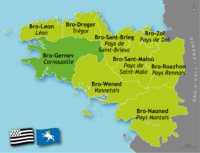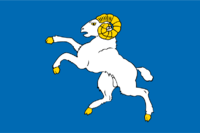
Cornouaille
Encyclopedia


Brittany
Brittany is a cultural and administrative region in the north-west of France. Previously a kingdom and then a duchy, Brittany was united to the Kingdom of France in 1532 as a province. Brittany has also been referred to as Less, Lesser or Little Britain...
, in northwest France
France
The French Republic , The French Republic , The French Republic , (commonly known as France , is a unitary semi-presidential republic in Western Europe with several overseas territories and islands located on other continents and in the Indian, Pacific, and Atlantic oceans. Metropolitan France...
. The name is identical to the French name for the Duchy of Cornwall
Cornwall
Cornwall is a unitary authority and ceremonial county of England, within the United Kingdom. It is bordered to the north and west by the Celtic Sea, to the south by the English Channel, and to the east by the county of Devon, over the River Tamar. Cornwall has a population of , and covers an area of...
, since the area was settled by migrant princes from Cornwall. At this time, the same language was spoken on both sides of the Channel, which evolved into a dialect, the Cornish language
Cornish language
Cornish is a Brythonic Celtic language and a recognised minority language of the United Kingdom. Along with Welsh and Breton, it is directly descended from the ancient British language spoken throughout much of Britain before the English language came to dominate...
in the island, and into a similar dialect, the Breton language
Breton language
Breton is a Celtic language spoken in Brittany , France. Breton is a Brythonic language, descended from the Celtic British language brought from Great Britain to Armorica by migrating Britons during the Early Middle Ages. Like the other Brythonic languages, Welsh and Cornish, it is classified as...
on the continent. However, in French the British Cornwall is referred to as "Les Cornouailles" in the plural to distinguish it from the Breton region.
Origin of name
Cornouaille was established in the early Middle Ages in the southwest of the Breton peninsula. During this same period other British migrants established the region of Dumnonia (in LatinLatin
Latin is an Italic language originally spoken in Latium and Ancient Rome. It, along with most European languages, is a descendant of the ancient Proto-Indo-European language. Although it is considered a dead language, a number of scholars and members of the Christian clergy speak it fluently, and...
) or Domnonée (in French) in the north of the peninsula, taken from the British county of Devon
Devon
Devon is a large county in southwestern England. The county is sometimes referred to as Devonshire, although the term is rarely used inside the county itself as the county has never been officially "shired", it often indicates a traditional or historical context.The county shares borders with...
derived from the Latin Dumnonia
Dumnonia
Dumnonia is the Latinised name for the Brythonic kingdom in sub-Roman Britain between the late 4th and late 8th centuries, located in the farther parts of the south-west peninsula of Great Britain...
. We see the case of identical name for two kingdoms: for example, the "Gwened" in south Brittany (Vannes
Vannes
Vannes is a commune in the Morbihan department in Brittany in north-western France. It was founded over 2000 years ago.-Geography:Vannes is located on the Gulf of Morbihan at the mouth of two rivers, the Marle and the Vincin. It is around 100 km northwest of Nantes and 450 km south west...
) (this region is called after its iron-age inhabitants, the "Veneti", in Breton "Weneted") and the Welsh "Gwynedd";or the Parisii in both modern Yorkshire and the area around modern Paris.
The region was first mentioned by this name between 852
852
Year 852 was a leap year starting on Friday of the Julian calendar.- Europe :* Saint Swithun becomes Bishop of Winchester, England....
and 857
857
Year 857 was a common year starting on Friday of the Julian calendar.- Byzantine Empire :* Michael III of Byzantium, under the influence of his uncle Bardas, banishes his mother Theodora...
when the Bishop of Saint-Corentin, Anaweten, took over "Cornugallensis". The name Cornwall or Corn-wealas is from the name of Celtic tribe, Latinized as Cornovii, meaning "peninsula people", (from the Celtic "kernou", meaning "horn" or "headland". A cognate of the English "horn", both being from PIE *ker- "uppermost part of the body, head, horn, top, summit") with the suffix "-wealas", from "walh", a word used by the Germanic speakers, such as the English, for "a non-Germanic foreigner" especially a "Celtic speaker" but also used for Romance speakers
Romance languages
The Romance languages are a branch of the Indo-European language family, more precisely of the Italic languages subfamily, comprising all the languages that descend from Vulgar Latin, the language of ancient Rome...
(and is the element found in Walloon, Wales
Wales
Wales is a country that is part of the United Kingdom and the island of Great Britain, bordered by England to its east and the Atlantic Ocean and Irish Sea to its west. It has a population of three million, and a total area of 20,779 km²...
, Walachia, walnut
Walnut
Juglans is a plant genus of the family Juglandaceae, the seeds of which are known as walnuts. They are deciduous trees, 10–40 meters tall , with pinnate leaves 200–900 millimetres long , with 5–25 leaflets; the shoots have chambered pith, a character shared with the wingnuts , but not the hickories...
, Wallace
Wallace
-People:* Wallace * Richard Horatio Edgar Wallace , English crime writer, journalist, novelist, screenwriter, and playwright.* Clan Wallace in Scotland* William Wallace, a famous Scottish knight, and Guardian of Scotland...
and Walsh
Walsh
-People:*See Walsh for the origin of the surname Walsh and people with the surname Walsh-Mathematics:* Walsh functions, an orthogonal basis of the square-integrable functions on the unit interval...
). The name was used in reference to the resettling of the Celts from 'Great Britain' as opposed to 'Lesser Britain', the difference between 'La Grande Bretagne' – Great Britain – and 'La Bretagne', Brittany.
History
Strong contacts between ArmoricaArmorica
Armorica or Aremorica is the name given in ancient times to the part of Gaul that includes the Brittany peninsula and the territory between the Seine and Loire rivers, extending inland to an indeterminate point and down the Atlantic coast...
(Brittany) and southern Britain had already been noted by Julius Caesar
Julius Caesar
Gaius Julius Caesar was a Roman general and statesman and a distinguished writer of Latin prose. He played a critical role in the gradual transformation of the Roman Republic into the Roman Empire....
. Native British troops were hired to support the usurpation of Magnus Maximus
Magnus Maximus
Magnus Maximus , also known as Maximianus and Macsen Wledig in Welsh, was Western Roman Emperor from 383 to 388. As commander of Britain, he usurped the throne against Emperor Gratian in 383...
, who is said to have settled them in Armorica. Settlements expanded when Anglo-Saxons expanded within Britain. Strong links existed in the 6th century between the British and Armorican territories. Arthurian legends make frequent reference to the maritime connections between the peoples of Wales, southern Ireland, southwest Britain and Brittany, cf. the tale of Tristram and Yseult
Tristan and Iseult
The legend of Tristan and Iseult is an influential romance and tragedy, retold in numerous sources with as many variations. The tragic story is of the adulterous love between the Cornish knight Tristan and the Irish princess Iseult...
.
The existence of a district of ancient Anjou
Anjou
Anjou is a former county , duchy and province centred on the city of Angers in the lower Loire Valley of western France. It corresponds largely to the present-day département of Maine-et-Loire...
called "La Cornuaille" has led to the hypothesis that it was a geographical or military label for all of southern Brittany
Brittany
Brittany is a cultural and administrative region in the north-west of France. Previously a kingdom and then a duchy, Brittany was united to the Kingdom of France in 1532 as a province. Brittany has also been referred to as Less, Lesser or Little Britain...
as far as the northern shore of la Domnonée in the 6th or 7th century.
At the origin of this feudal county
County
A county is a jurisdiction of local government in certain modern nations. Historically in mainland Europe, the original French term, comté, and its equivalents in other languages denoted a jurisdiction under the sovereignty of a count A county is a jurisdiction of local government in certain...
, the reigning dynasty acceded to a dukedom of the region, which then passed to the bishop of Quimper.
In Breton
Breton language
Breton is a Celtic language spoken in Brittany , France. Breton is a Brythonic language, descended from the Celtic British language brought from Great Britain to Armorica by migrating Britons during the Early Middle Ages. Like the other Brythonic languages, Welsh and Cornish, it is classified as...
, Cornouaille, as well as Cornwall, is known as "Kernev" or "Bro-Gernev", and in Latin
Latin
Latin is an Italic language originally spoken in Latium and Ancient Rome. It, along with most European languages, is a descendant of the ancient Proto-Indo-European language. Although it is considered a dead language, a number of scholars and members of the Christian clergy speak it fluently, and...
as "Cornugallia" or "Cornubia". In Cornish, "Kernev" is written "Kernow", but the pronunciation is the same.
Diocese
The name Cornouaille signifies the dioceseDiocese
A diocese is the district or see under the supervision of a bishop. It is divided into parishes.An archdiocese is more significant than a diocese. An archdiocese is presided over by an archbishop whose see may have or had importance due to size or historical significance...
of Quimper which persisted until the French Revolution
French Revolution
The French Revolution , sometimes distinguished as the 'Great French Revolution' , was a period of radical social and political upheaval in France and Europe. The absolute monarchy that had ruled France for centuries collapsed in three years...
. The diocese covered more than half of the south of Finistère
Finistère
Finistère is a département of France, in the extreme west of Brittany.-History:The name Finistère derives from the Latin Finis Terræ, meaning end of the earth, and may be compared with Land's End on the opposite side of the English Channel...
, and extended over part of Morbihan
Morbihan
Morbihan is a department in Brittany, situated in the northwest of France. It is named after the Morbihan , the enclosed sea that is the principal feature of the coastline.-History:...
and the Côtes-d'Armor
Côtes-d'Armor
Côtes-d'Armor is a department in the north of Brittany, in northwestern France.-History:Côtes-du-Nord was one of the original 83 departments created during the French Revolution on 4 March 1790. It was created from part of the former province of Brittany. Its name was changed in 1990 to...
. There were two arch-deacons, one for Cornouaille and one for Poher. There were also a cantor, a treasurer, a theologian and twelve canons. This episcopal division was the poorest in Brittany.
After the French Revolution, the new constitution created a diocese of Finistère, erasing that of the diocese of Kerne (diocese of Cournouaille); most of the old diocese was absorbed into the new.

